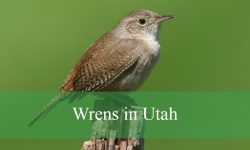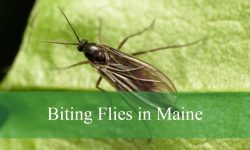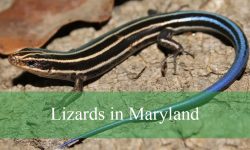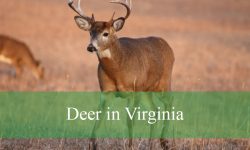Georgia’s diverse natural landscapes—ranging from coastal marshes to Appalachian foothills—provide a rich habitat for a variety of bird species, including the often-overlooked wrens. Small, energetic, and full of character, wrens in Georgia charm birdwatchers with their bold behavior, musical voices, and surprising adaptability. Though they may be tiny in size, these birds have loud songs and even louder personalities.
From dense forest underbrush to marshy wetlands, wrens in Georgia occupy a range of environments throughout the state. Some species are year-round residents, while others appear only during migration or winter months. Despite their secretive nature, they can often be spotted flitting among shrubs or heard singing from hidden perches. Identifying them takes a bit of patience, but their distinctive calls and tail-flicking habits make them stand out.
In this guide, we’ll explore seven types of wrens in Georgia, including how to identify them, where to find them, and what makes each one unique. With photos, song descriptions, and behavior tips, this article is designed to help bird enthusiasts and casual observers alike appreciate the rich variety of wrens that call Georgia home.
Different Types of Wrens Found in Georgia
Carolina Wren (Thryothorus ludovicianus)

The Carolina Wren is a small, stocky bird with a distinctive warm cinnamon-brown color on its upperparts and a rich buffy-orange underbelly. It has a bold white eyebrow stripe (supercilium), a slightly curved bill, and a relatively long tail often held upright. Males and females look alike and measure around 5.5 inches (14 cm) in length with a wingspan of about 7.5 inches. This species is known for its active and curious nature, often hopping through dense vegetation or probing into crevices.
Easily recognized by its loud, ringing song, the Carolina Wren delivers a clear “tea-kettle, tea-kettle, tea-kettle” or “cheery-cheery-cheery” call that carries across woodlands. Both sexes produce a variety of calls and chatters, but the male’s song is especially prominent. Its vocalizations can be heard year-round and are particularly frequent during early mornings and late afternoons.
Carolina Wrens are year-round residents in Georgia, commonly found in a variety of habitats including deciduous forests, forest edges, overgrown brush, suburban yards, and gardens. They prefer areas with dense undergrowth, tangled vines, and fallen logs that provide good foraging and nesting cover. These wrens build dome-shaped nests with side entrances, often tucked into cavities, hanging planters, or even inside garages and mailboxes.
Their diet primarily consists of insects and spiders, including beetles, caterpillars, ants, and grasshoppers. Occasionally, they will eat seeds and small fruits, especially in winter when insects are scarce. Carolina Wrens are also frequent visitors at backyard feeders, where they may take suet or mealworms, especially during colder months when natural food is limited.
House Wren (Troglodytes aedon)
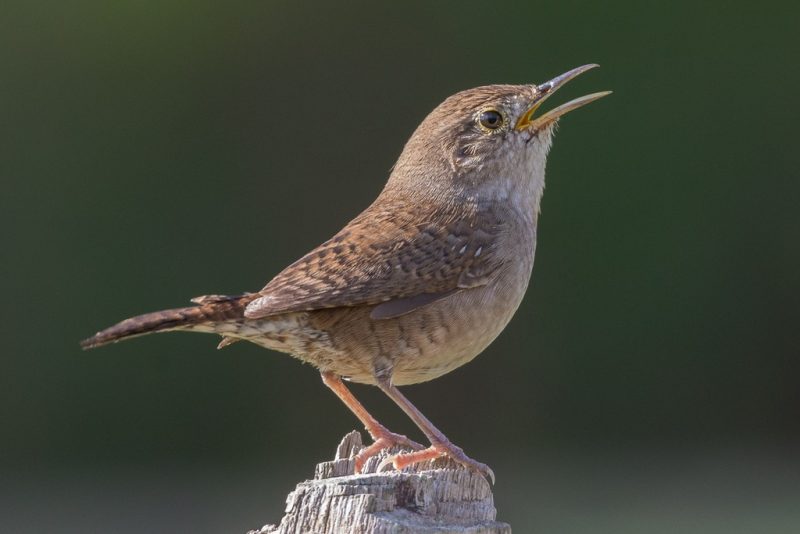
The House Wren is a tiny, energetic bird with subtle brown plumage. It has faint barring on the wings and tail, a pale throat and chest, and a slightly downcurved beak. At around 4.75 inches (12 cm) long with a wingspan of about 6 inches (15 cm), it is smaller and more muted in color compared to the Carolina Wren. Despite its plain appearance, it compensates with lively movement and an enthusiastic personality.
This species is highly vocal, known for its bubbly, trilling song that includes a series of rapid, descending notes. The male sings persistently during the breeding season to defend his territory and attract a mate. House Wrens are also known for their harsh chattering calls when alarmed or agitated.
In Georgia, House Wrens are most commonly seen during migration and the breeding season. They favor open woodlands, shrubby fields, parks, and residential areas with plenty of brush piles, nest boxes, or crevices to explore. Though not as common in southern Georgia year-round, they are reliable breeders in northern and central regions during spring and summer.
Insectivorous by nature, House Wrens consume a wide range of bugs including beetles, flies, caterpillars, and spiders. They actively forage by flitting through low vegetation or hopping across the ground in search of prey. Their adaptability and willingness to nest close to human structures make them a common backyard bird where nesting boxes are available.
Winter Wren (Troglodytes hiemalis)

The Winter Wren is the smallest and one of the most secretive of the wrens found in Georgia. It has a round body, very short tail often cocked upward, and a dark brown coloration with fine barring across the flanks and wings. Measuring only about 4 inches (10 cm) long with a wingspan of 5.5 inches (14 cm), this compact bird is easy to overlook as it creeps low through forest undergrowth.
Its song is surprisingly loud and complex for such a tiny bird, consisting of a cascading, bubbly series of trills and whistles delivered in rapid succession. Though the song is beautiful, it is rarely heard in Georgia since this species breeds farther north and typically sings during the nesting season. In winter, its vocalizations are limited to high-pitched call notes.
Winter Wrens are winter visitors in Georgia, most often found in dense, shaded woodlands with heavy underbrush, especially near streams or fallen logs. They prefer moist environments where they can forage for insects among leaf litter and decaying wood. Their secretive behavior and preference for thick cover make them a challenge to spot.
Their diet consists mainly of small insects, larvae, and spiders, which they pick out of moss, bark, and ground debris. Occasionally, they will supplement their diet with seeds. Winter Wrens are solitary and territorial, even during the colder months, and they spend much of their time quietly foraging near the forest floor.
Marsh Wren (Cistothorus palustris)
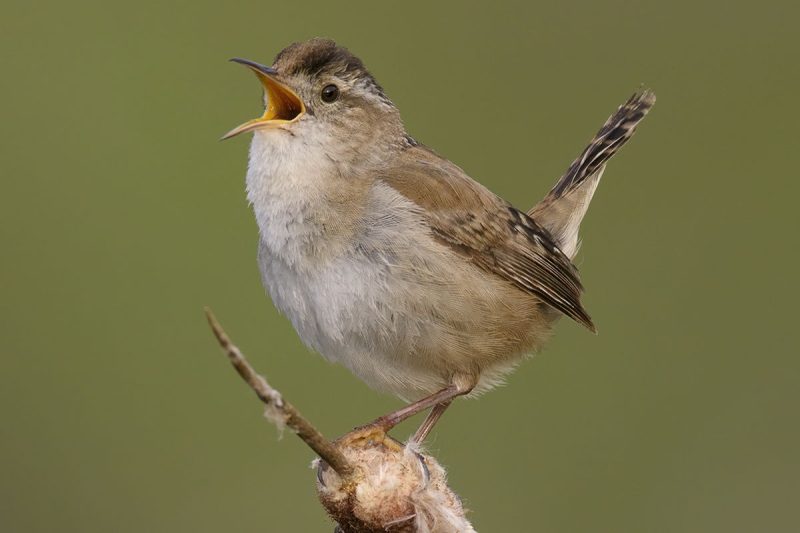
The Marsh Wren is a slender, active bird with a bold white eyebrow stripe, dark cap, and streaked back. Its underparts are buffy to pale gray, and its tail is short and typically held upright. It measures about 5 inches (13 cm) in length with a wingspan of roughly 6.5 inches (17 cm). This wren is well-adapted to living among dense reeds and cattails, where it stays low and often out of sight.
One of the noisiest wrens, the Marsh Wren’s song is a gurgling series of raspy, mechanical trills and buzzes, often repeated from hidden perches deep in the marsh. Males sing continuously during breeding season and will often build several “dummy” nests in their territory to attract females and deter rivals.
In Georgia, Marsh Wrens are primarily seen during migration and winter, though some populations may breed in suitable habitats in the northern part of the state. Their preferred habitat includes freshwater and brackish marshes with thick stands of emergent vegetation like cattails and bulrushes. They are rarely seen far from water.
Their diet consists almost entirely of insects and other invertebrates, including midges, beetles, and small aquatic larvae. Marsh Wrens forage by climbing through vegetation or hanging upside-down to reach prey. Their elusive behavior, combined with their dense wetland habitat, often means they are more often heard than seen.
Sedge Wren (Cistothorus stellaris)
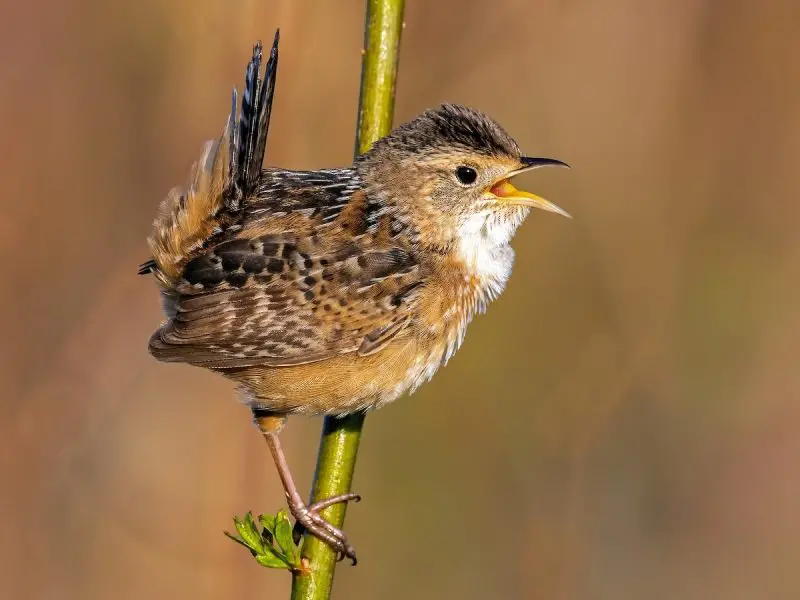
The Sedge Wren is a small, secretive songbird with a compact body and short tail often cocked upright. Its plumage is brown and heavily streaked with black on the back and crown, contrasting with pale underparts. A faint white eyebrow stripe adds to its delicate appearance. Measuring about 4.5 inches (11.5 cm) in length and weighing less than 10 grams, this species is one of the smallest wrens in North America.
Its song is short and dry, composed of a few introductory notes followed by a rapid, chattering trill that resembles the sound of a sewing machine. Males sing repeatedly during the breeding season and are often only detected by their calls, as these birds remain well-hidden in grassy vegetation. Their calls and songs are less musical than some other wren species, but distinct and persistent.
In Georgia, the Sedge Wren is a scarce and localized breeder, more commonly encountered during migration or in the winter. It prefers wet meadows, sedge fields, and grassy marshes with low, dense vegetation. Unlike the Marsh Wren, it typically avoids tall cattail stands. This bird’s nesting behavior is somewhat nomadic, and it will often shift breeding locations depending on vegetation and moisture conditions.
Sedge Wrens primarily feed on insects and spiders, gleaning prey from grasses and sedges. They are quick and elusive foragers, often darting in and out of cover. Their cryptic behavior and remote habitat make them challenging to study, but they play an important ecological role in controlling insect populations in wetland environments.
Bewick’s Wren (Thryomanes bewickii)
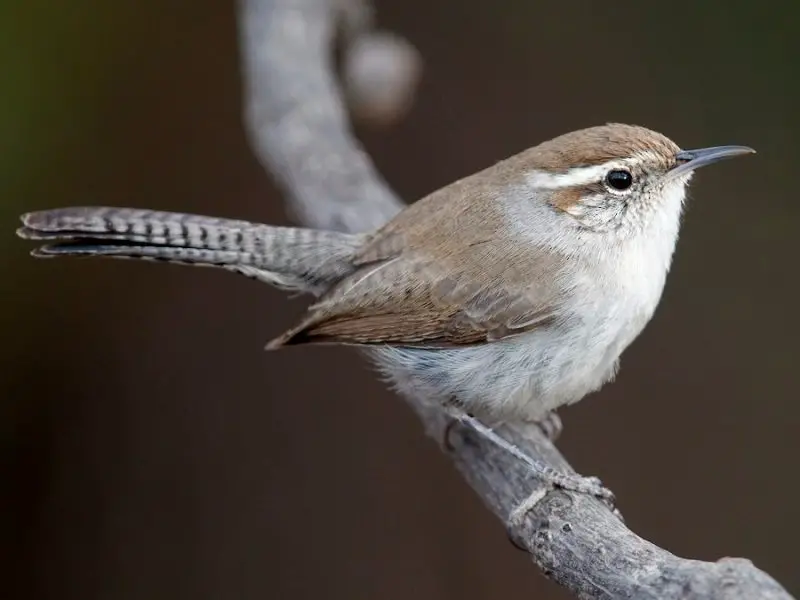
Bewick’s Wren is a slender, medium-sized wren with a long tail that is often flicked from side to side. It has a warm brown back, grayish-white underparts, and a very noticeable white eyebrow stripe. Its tail is barred with black and white tips, which aids in identification. Measuring around 5.5 inches (14 cm) in length with a wingspan of about 7 inches (18 cm), this species is slightly longer than the House Wren.
Its song is rich and varied, typically beginning with a few high-pitched notes and ending in musical trills or warbles. Each male has a repertoire of different song patterns, which he uses to defend his territory and attract a mate. In addition to singing, Bewick’s Wrens emit harsh scolding calls when alarmed or disturbed.
Historically more widespread in the eastern United States, including Georgia, the Bewick’s Wren has become increasingly rare in the region due to habitat loss and competition from the House Wren. Today, it is considered extremely uncommon in Georgia, with most records occurring in the western and northern parts of the state. It prefers open woodlands, brushy slopes, and old fields with scattered trees and dense understory.
Its diet consists mainly of insects and larvae, such as caterpillars, beetles, ants, and spiders. Bewick’s Wrens forage actively by hopping and climbing through shrubs, vines, and low tree branches. They occasionally eat seeds or berries, especially in the colder months. Though now rarely seen in Georgia, the species remains common in parts of the western U.S.
Rock Wren (Salpinctes obsoletus)
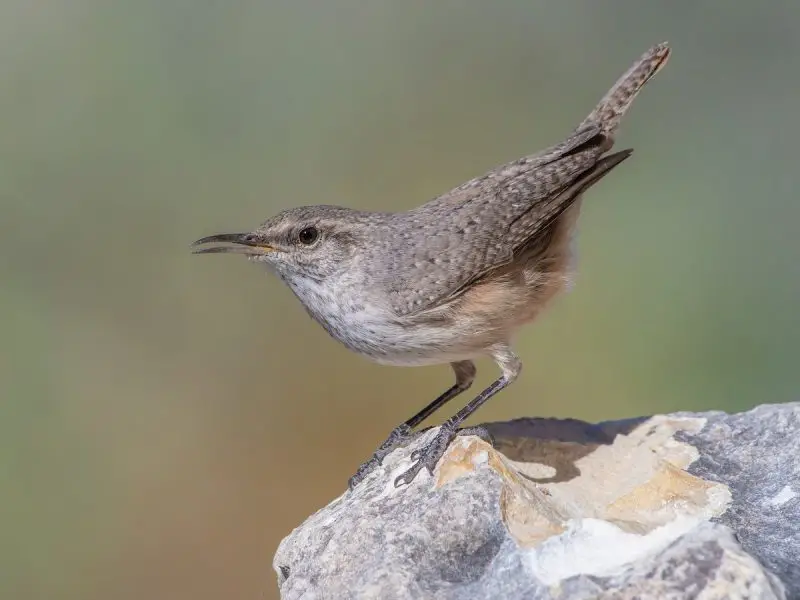
The Rock Wren is a pale, long-legged wren with a lightly speckled gray-brown back and white underparts faintly washed with buff along the sides and belly. It has a relatively long bill, a short barred tail, and a pale eyebrow stripe. Measuring about 5.9 inches (15 cm) in length, this bird is built for bouncing across rocky terrain and hopping along boulders.
Its song is a series of varied, musical phrases that can include whistles, trills, and chipping notes. Males sing from prominent perches like rocks or fence posts, especially during the breeding season. Their song is pleasant and variable, with individuals incorporating dozens of different phrases into their repertoires.
In Georgia, the Rock Wren is an extremely rare visitor, typically recorded only during migration or due to misdirection. Its core range lies in the arid and semi-arid regions of the western United States, where it inhabits rocky hillsides, canyons, cliffs, and outcrops. When it does appear in Georgia, it’s usually in winter or during a vagrancy event, often in gravelly or rocky human-modified habitats like construction zones or quarries.
The Rock Wren feeds primarily on insects, including beetles, ants, and grasshoppers, which it hunts on the ground by hopping and scanning crevices and rocks. It occasionally supplements its diet with seeds. Even in areas where it is more common, the Rock Wren remains tied to rocky or open, sparsely vegetated environments that mimic its native western habitats.


